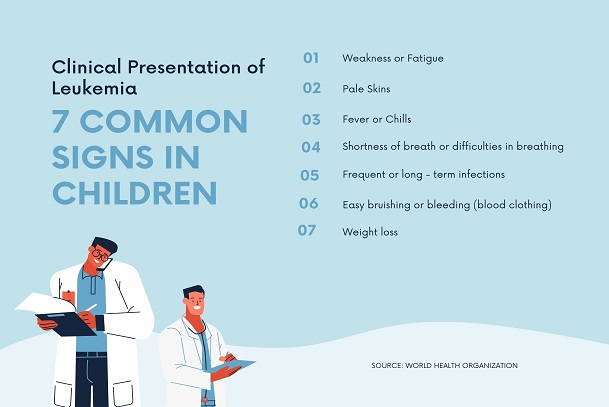Leukemia, as explained in the previous article, is a blood cancer caused by the increase in the number of white blood cells in the human body. It’s one of the common cancer infections that affect young adults and children.
Just like any other type of cancer, leukemia has its unique signs and symptoms, which is dependent upon the type of leukemia in the blood system. As earlier stated in the previous article; leukemia that are chronic or grows slowly tend not to cause any form of symptoms its earlier stages, but once the cancer begins to grow, various symptoms begin to manifest clinically.
Aggressive or rapid growing leukemia does manifest its symptom at its early stage yet they could also lead to severe symptoms; arising from loss of function by normal blood cells or from the accumulation of abnormal cells in the body.
Typical signs and symptoms of leukemia may include the followings:
- Weakness or Fatigue: This is an overall feeling of being tired and lack of energy. During this time, the body seems to lack any form of motivation or energy to do anything.
- Poor Blood Clotting: This causes easy bruising or bleeding which heals slowly; which can over time develop into petechiae, which are small red and purple spots on the body. Petechiae develops when white blood cells in the body are immature, crowding out the platelets that are essential for blood clotting.
- Fever or Chills: At this stage, the body temperatures begin to rise above the normal body temperature (98 – 100OF / 36 – 37OC).
- Weight Loss: This is the unintentional or unexplainable loss of the human body mass. Weight loss may also occur even without an enlarged liver or spleen.
- Frequent Infections: The white blood cells are an important part of the blood system which helps in fighting any form of infections. But the moment there is an abnormal functioning of the white blood cells, the body may develop frequent infections due to consistent attack by the body’s own cell.
- Anemia: Once the red blood cells in the body become fewer, an individual may become anemic i.e. not having enough hemoglobin in the blood cells. The hemoglobin helps to transport iron around the body, and once there is shortage of iron in the body, it could lead to having difficulties in breathing or pale skin.
- Night Sweats: Although without diagnosis, the presence of leukemia can’t be ascertain by excessive sweating, yet excessive sweating especially at night could be a symptom of leukemia presence in the body.
- Swollen Lymph Nodes: The body experience painless and swollen lymph nodes especially around the neck and the armpits during leukemia.
- Enlarged Liver or Spleen: Once the liver or spleen becomes swollen, a person may feel full and eat less, resulting in weight loss.
- Joint or Bone Pains and Tenderness
- Recurrent Nosebleeds
- Flu-like Symptoms
Once leukemia cells infiltrate the central nervous system such as the brain, symptoms such as headaches, seizures, loss of muscle control and vomiting may also occur.
However, all these can all be symptoms of other illnesses. Consultation and testing are necessary to confirm a diagnosis of leukemia.
Just like other cancers, leukemia can also spread to other parts of the body including the gastrointestinal tract; lungs; heart; kidneys and testes.
 Wash your hands regularly and wear a face mask.
Learn more
Wash your hands regularly and wear a face mask.
Learn more
